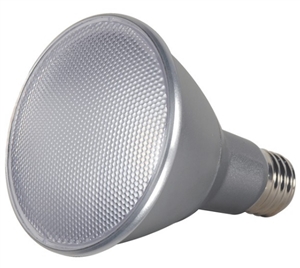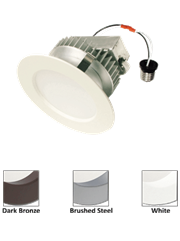Description
This high-quality spotlight is perfect for those hard-to-reach places where it’s difficult or dangerous to change the light bulb. Three unique beam distributions + dimming capabilities allow for great application flexibility. This LED bulb is suitable for wet applications–so it is perfect for any outdoor situation where up to a 120W equivalent of light is needed.
Highlights
This bulb is 80% more efficient than comparable 90/120 watt halogen or incandescent lamps and lasts 16 times longer than halogen lighting. The savings will pay for the bulb in no time–using one of these bulbs 6 hours a day will give you 22.8 years of life!
-18/24 watts (90/120W equivalent)
-E26/GU24 Socket
-50,000 hour life
-120 VAC
-RoHS Compliant
-Aluminum housing
-3000K Warm White Color Temperature
“Changing a light bulb sounds like an easy process, and sometimes it is. However, there are important safety measures to keep in mind. Sometimes, you will need to replace a light bulb that is trickier. For example, perhaps the bulb is in a very high vaulted ceiling or is a car dome light.
1. Make sure the power is turned off. This is a good idea any time you are messing around with electrical fixtures. Why not be safe?
- Just switch the red power button to “off” in your fuse box. Be aware this will shut off all of your power, not just for one fixture.
- You should also unplug the lighting fixture before you change the light bulb (if it’s a fixture with a plug, that is). If you don’t, you could risk getting shocked. Always be careful around electricity.
- Take other safety measures. There are a few things you should keep in mind, especially if the bulb is high up in the ceiling.
- Let the bulb cool off before you unscrew it. If the light was on recently, the bulb will be hot to the touch, and you could burn your fingers.
- If the bulb is in a ceiling fixture, don’t try to balance on an unsteady chair or something similar. Use a sturdy stepladder. That way you can reach the light bulb without falling.
- Instead of a step ladder, you can buy a special extension tool to switch a light bulb that is very high up. This is often safer than trying to climb a ladder. And remember: You could always hire a handyman! You shouldn’t need any other tools to change a light bulb in a lamp fixture.
- Take the bulb out of the socket. If the fixture is easy to reach, such as a lamp, the process is pretty straightforward. Sockets do differ depending on your lighting fixture.
- If you have a bayonet mount, which is common in the UK and places like New Zealand, hold the bulb gently but firmly, and then push down and turn the bulb counter-clockwise. This should release it from the socket. This type of socket has two prongs.
- If the socket has a screw fitting, which is common in America and throughout Europe, you should gently twist the bulb counter clockwise. It should then come loose from the socket, and you can remove it.
- Put a new bulb in the socket. In order to put a new bulb into a lighting fixture’s socket, you will want to turn the bulb in a clockwise direction. Just remember: Counter-clockwise to remove; clockwise to insert.
- The bulb might lock into place or you might have to twist it a bit until you can’t twist it anymore. This will depend on the socket. Don’t screw the bulb too tight or it could break. If you have a bayonet bulb, you will need to align the bulb’s base with the two pins. Push down and then twist upwards, using a clockwise motion.
- In the case of a screw cap bulb, simply place it into the hole and then twist it. You will usually want to choose a bulb that has the same wattage as the old bulb unless you want softer or brighter light than what you already had.
- Check the label on the bulb socket or fixture for the max watt/amp rating. Make sure the bulb’s power rating doesn’t exceed that allowed by your lighting fixture (check with the manufacturer or packaging).
- Get rid of the bulb safely. Be aware that light bulbs are very fragile. Thus, you don’t want to just toss them haphazardly in your garbage can. If the bulb breaks, the shards can cut someone.
- Wrap the old bulb in the new bulb’s package before throwing it away. You could also wrap the old bulb in a newspaper or old magazine.
- Throw the bulb away in places that children can’t reach. Make sure to recycle the bulb if possible or required in your area.”
https://www.wikihow.com/Change-a-Light-Bulb








Reviews
There are no reviews yet.